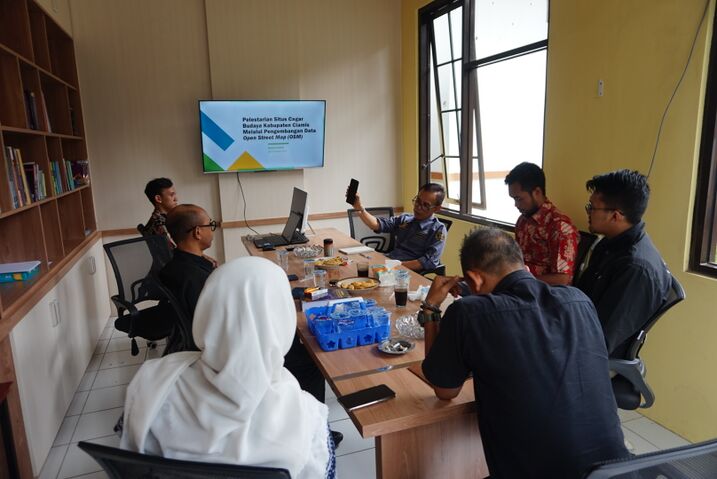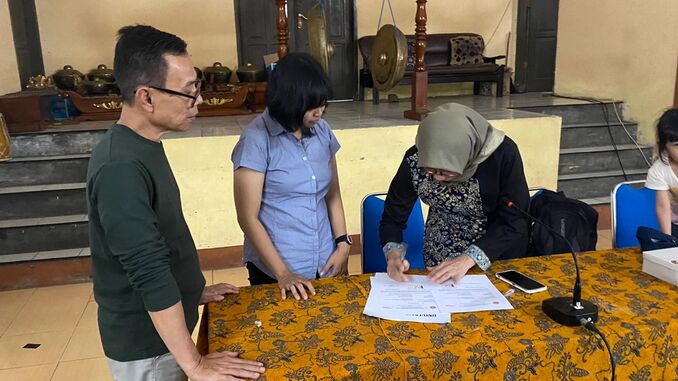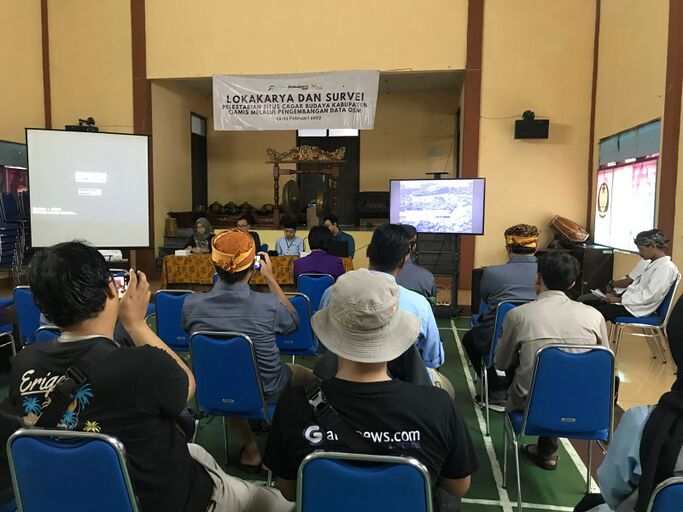Niskala Institute: Preservation of Ciamis Regency Cultural Heritage Through OSM Data
The preservation of cultural heritage has now become part of sustainable development efforts, as mandated by Law No. 11 of 2010 on the Preservation of Cultural Heritage in Indonesia. The existence of immovable cultural heritage, such as structures, buildings, sites, and cultural heritage areas, is closely related to the evolving spatial conditions, making access to up-to-date information on the condition of cultural heritage sites crucial for their preservation.
Currently, the availability of information, particularly in digital platforms related to cultural heritage, is very limited. The only platform that provides such data is the website managed by the Ministry of Education and Culture through the cagarbudaya.kemdikbud.go.id portal. However, the data available on this website is limited to cultural heritage sites with national-level significance, while cultural heritage sites at the district level or suspected cultural heritage objects are not well-represented.
In the efforts to preserve cultural heritage, stakeholders at the regional level, such as the Cultural Office of the District, the Expert Team on Cultural Heritage of the District, and the Community Groups of Cultural Heritage Owners/Managers/Lovers, play a crucial role. These stakeholders need to be involved, especially in promoting the availability of information about cultural heritage. To support these efforts, a media platform that can foster a shared understanding of the importance of cultural heritage preservation is needed.
The media platform provided for engaging multiple stakeholders in cultural heritage preservation should be easily accessible, so that everyone can participate in preserving cultural heritage through the development of the platform. In this regard, OpenStreetMap (OSM), as a digital media that can provide spatial data and has an inclusive mapping approach, can be a suitable choice for this purpose. Therefore, the introduction of OSM in the context of cultural heritage preservation is essential and needs to be accelerated.
Solution
The availability of information on cultural heritage at the local level is still very limited, especially information that is focused on efforts to preserve cultural heritage. In addition, the media used to encourage the provision of such information is also very limited. This has led to a lack of understanding and involvement of various parties in the efforts to preserve cultural heritage. Through workshops and the provision of information about cultural heritage sites or objects suspected of being cultural heritage in Ciamis Regency, public understanding of cultural heritage preservation activities can be increased. This will also provide data that can be used as a basis for developing strategies for preserving cultural heritage in Ciamis Regency, as well as attract more people to participate in these efforts.
Implementation
The activities that have been carried out until the middle of the program implementation have been progressing well. Many parties have welcomed and actively supported the program, particularly the Ciamis Regency Cultural Office, the Cultural Heritage Expert Team of Ciamis Regency, and the local community/groups of cultural heritage owners/managers/enthusiasts in Ciamis Regency.
Activities
Hearing and Negotiation Phase
The stage of audience and permit management is aimed at obtaining input regarding the implementation of activities and the provision of human resources and logistical needs for the activities. This stage also serves as an agreement on the timing and technical aspects of the activity implementation. The audience is primarily targeted at the local government, represented by the Ciamis Regency Cultural Office, and attended by representatives of the Cultural Heritage Expert Team of Ciamis Regency. As a result, the community has received positive responses, permits, and feedback regarding the implementation of the activities from all parties present. The parties also have positive expectations for the sustainability of the activities. It is hoped that the community can continue to promote conservation efforts through various activities, especially in the development of human resources and effective media to encourage cultural heritage conservation activities in Ciamis Regency. The Ciamis Regency Cultural Office will make efforts to support the sustainability of the activities in the coming years.
Workshop
The workshop takes place in the hall of the Ciamis Regency Cultural Office from 09.00 to 15.00 WIB. It is attended by four speakers representing the Ciamis Regency Cultural Office, the Cultural Heritage Expert Team as well as the History Education Program of Galuh University, OSM Indonesia Association, and Niskala Institute. The material presented by the speakers is generally divided into two parts, namely the potential of cultural heritage in Ciamis Regency and the challenges and efforts of its conservation, especially through digital media such as OSM.
The workshop aims to build understanding among participants about the potential of cultural heritage in Ciamis Regency and its conservation efforts, including the importance of utilizing digital media such as those developed by OSM. This understanding is crucial for the conservation of cultural heritage, particularly through the development of cultural heritage data into information that can attract more stakeholders to participate in its conservation efforts.
Field Survey
The participants in the survey conducted on February 11, 2023, totaled 23 people, consisting of representatives from students and cultural enthusiasts from Ciamis Regency, as well as 6 facilitators from the Niskala Institute community and 3 representatives from the Ciamis Regency Cultural Office. The survey was conducted at 3 sites located in the center of Ciamis Regency, namely the old pendopo site, the klenteng (Chinese temple) site, and the cemetery site. Each of these locations is expected to represent different types of cultural heritage scattered throughout Ciamis Regency, including cultural heritage in the form of buildings and structures, as well as those managed by the government and the community.
The aim of this survey activity is to build understanding among participants on how to read the cultural heritage site data collection form, which serves as an initial guide for cultural heritage documentation. By understanding this data collection form, participants are expected to have an overview of the components that can be presented on a map as information on the distribution of cultural heritage in Ciamis Regency. These components in the form are important for conducting analysis and presenting information about cultural heritage in Ciamis Regency.
Data Compilation and Visualization
The data processing phase was carried out in the fourth week of February 2023 by members of the Niskala Institute community. The distribution data of cultural heritage sites were collected by cultural enthusiasts in Ciamis Regency and then verified by members of the Niskala Institute during the data processing phase. Data processing was done using the QGIS application, which presented coordinate points with classified data based on the type of cultural heritage and its management form. Information on the distribution of cultural heritage, including its type and management form, is important to be presented and understood by stakeholders. This information not only builds understanding about the concentration of cultural heritage distribution, but also the potential and challenges of cultural heritage preservation based on its type and management form.
In order to present information about cultural heritage sites, an analysis of preservation is needed on the data of cultural heritage sites before they are presented as cultural heritage site information. This is an important step to ensure that the information about cultural heritage sites can serve as a basis for stakeholders who will be involved in cultural heritage preservation activities. Preservation of cultural heritage sites or objects, as stipulated in Law No. 11 of 2010 on Cultural Heritage, is divided into three aspects: protection, development, and utilization. Each aspect of site preservation requires different information needs to support preservation efforts. Some information that can be provided based on the aspects of preservation can be categorized as follows.
| Preservation Aspects | Clusterization | Description |
| Protection | Site Form: Structure, Building, or Site | According to the Law on Cultural Heritage No. 11 of 2010, cultural heritage sites are categorized into five forms, including structures, buildings, and sites. In Ciamis Regency, many identified sites are in the form of structures, buildings, and sites. These three forms have different protection efforts as cultural heritage, which makes clustering important, especially for local governments in developing protection strategies. |
| Expansion | Site Function: Secular or Non-Secular | The function of cultural heritage sites by communities can be differentiated based on the nature of their sacredness, whether they are considered sacred or profane, and those that are considered to have general functions beyond their sacredness or non-profane. Clustering based on their functions can provide an overview of the development of these sites, both physically and non-physically. |
| Utilization | Visitor Intensity: High or Low | The intensity of visitation can indicate the high benefits of cultural heritage sites for communities. The more people who visit the sites, the larger the coverage of the community that benefits from the existence of the sites as a collectively owned resource. |
The benefits of presenting information about cultural heritage sites can be assessed, among others, based on the information needs of the community as stakeholders in the effort to preserve cultural heritage sites. Each stakeholder in this case would have different information needs and objectives related to the preservation of cultural heritage sites. Based on this, identification of stakeholders based on their information needs and relevant aspects of cultural heritage site preservation should be conducted in the analysis phase.
Ouputs and Outcomes
For the Community:
- Collaboration with the Cultural Office of Ciamis Regency in conducting workshop activities.
- Signing of a Cooperation Agreement with the History Education Program of Galuh University.
For Activity Implementers:
- Development of a guideline form for cultural heritage data collection in Ciamis Regency.
- Capacity building of participants in the management of cultural heritage sites in Ciamis Regency through the development of OpenStreetMap (OSM) data, enabling the community to process and present cultural heritage data as part of OSM data development. Capacity building is measured by the output in the form of cultural heritage distribution maps and validation of OSM data.
- Introduction of new information media in the form of three types of cultural heritage distribution maps in Sukadana Subdistrict, Ciamis Regency.
Output/Products that have been obtained are the implementation of workshops and cultural heritage conservation surveys through OSM data development, as well as the establishment of a partnership agreement between Niskala Institute and the History Education Study Program at Galuh University to promote preservation activities in Ciamis Regency, particularly through the use of digital media such as OSM. The detailed outputs/products can be seen in the following table.
| Indicator | Contribution | Notes |
| Result | ||
| Outputs | ||
| Enhancement of human resources capacity in Ciamis Regency for the preservation of cultural heritage in Ciamis Regency through the development of OSM data | The activity was attended by 23 participants from representatives of Universitas Galuh students and Cultural Enthusiasts of Ciamis Regency. | The participants involved are expected to be the main drivers who will initiate the use of digital media such as OSM to maximize efforts in preserving cultural heritage in Ciamis District. |
| Existence of a collaboration agreement for cultural heritage preservation activities in Ciamis Regency. | Signing of the Memorandum of Understanding (MoU) between Niskala Institute and History Program of Galuh University. | The main form of activity, which is routine discussions, will be directed towards determining themes related to cultural heritage preservation using digital media such as OSM to encourage the involvement of more stakeholders in cultural heritage preservation activities. |
| Production of a map showing the distribution of cultural heritage sites in Ciamis Regency with a focus on Sukadana District. | There are 3 types of maps that are the result of the analysis of cultural heritage distribution based on aspects of cultural heritage conservation. | The resulting maps serve as informative models that can be used as a basis for policy-making by local governments and as a source of information for various stakeholders in promoting efforts for cultural heritage preservation. |
Challenges
There are several challenges and obstacles faced in the implementation of the activities, and the challenges and obstacles at each stage of the activities are as follows:
- Preparation and Planning : Limited shared understanding of the utilization of digital media like OSM in cultural heritage preservation activities, resulting in a lengthy process of technical preparation and agreement, especially since it is the first time for Niskala Institute to utilize digital media like OSM for cultural heritage preservation activities.
- Audience and Permit Management: The local government highly expects the utilization of digital media for cultural heritage preservation in Kabupaten Ciamis, resulting in high expectations from the local government for the outcomes of the activities. Limited availability of human resources with skills in managing digital media, resulting in a lengthy process of selecting participants for the activities and determining other forms of activities during the audience process. The Department of Culture in Kabupaten Ciamis is making efforts to promote capacity building in the utilization of digital media like OSM for cultural heritage preservation.
- Workshops and Site Surveys: The utilization of digital media like OSM in cultural heritage preservation in Kabupaten Ciamis is a new concept, requiring a lengthy process to build understanding and skills related to the activities. It is expected that these activities can be an initial step in utilizing OSM for cultural heritage preservation. Participants are not able to directly participate in data processing and registering data in the OSM platform, resulting in only initial understanding of the activities being conveyed, while the efforts of data processing and registering cultural heritage data in OSM are carried out by the Department of Kabupaten Ciamis and Niskala Institute.
- Data Processing and Presentation: Data availability for cultural heritage is limited, both from field data and secondary data, resulting in processed data that may not be of optimal quality. Limited availability of human resources for data collection and processing of cultural heritage, resulting in suboptimal efforts in collecting cultural heritage data. Field data obtained may have inconsistencies and inaccuracies, requiring special time for rechecking through communication with data collectors in the field. Utilization of technology and interactive media in presenting cultural heritage data is not yet optimal due to limited human resources, especially in terms of related skills. Not all obtained data can be presented due to time constraints in data analysis and processing. Cultural heritage is not yet a priority for the community as a resource that can be utilized for development, resulting in limited understanding among the community of the need for information or presentation of cultural heritage data.
Sustainability
Certainly, there are still many things that need to be added to continue promoting conservation activities in Ciamis Regency and utilizing OSM for cultural heritage conservation. The activities carried out so far are an important initial step to effectively promote cultural heritage conservation and involve various stakeholders, including academia, local government, and the community.
The process of documenting cultural heritage as part of cultural conservation efforts needs to be continuously carried out to assess the improvement in the quality of cultural heritage conservation in each area. The data collected by the Department of Culture and cultural enthusiasts in Ciamis Regency, after being processed through these activities, can be used as a basis for formulating medium and long-term strategies for cultural heritage conservation.
The information derived from the analysis of this data needs to be regularly updated and supplemented with detailed information to make it attractive to various stakeholders. The more diverse and numerous the stakeholders involved, the better the quality of information and conservation activities in Ciamis Regency is expected to be. Ultimately, the need for utilizing OSM in cultural heritage conservation will continue to exist for monitoring and evaluating the dynamics of cultural heritage conservation activities in Ciamis Regency.



